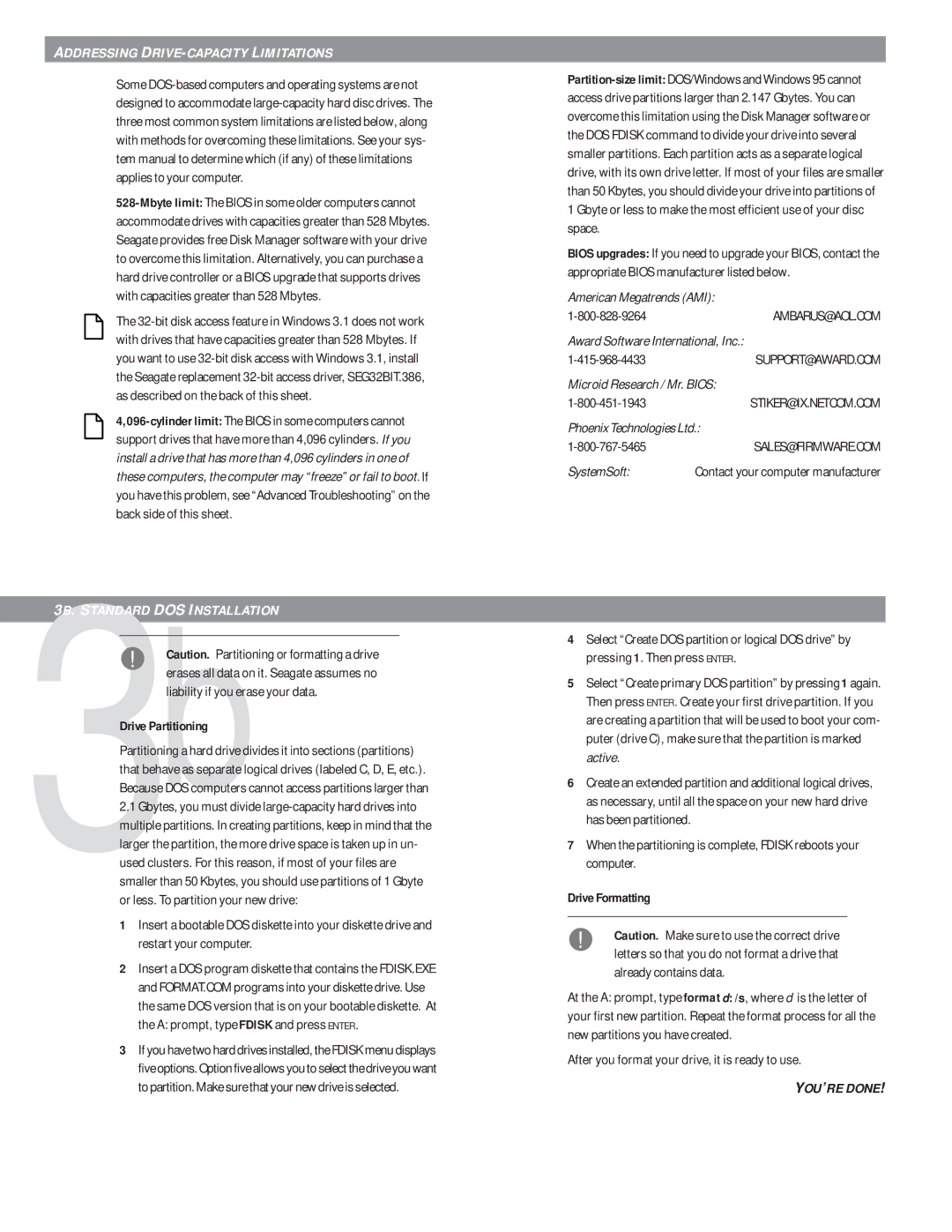ADDRESSING DRIVE-CAPACITY LIMITATIONS
Some DOS-based computers and operating systems are not designed to accommodate large-capacity hard disc drives. The three most common system limitations are listed below, along with methods for overcoming these limitations. See your sys- tem manual to determine which (if any) of these limitations applies to your computer.
528-Mbyte limit: The BIOS in some older computers cannot accommodate drives with capacities greater than 528 Mbytes. Seagate provides free Disk Manager software with your drive to overcome this limitation. Alternatively, you can purchase a hard drive controller or a BIOS upgrade that supports drives with capacities greater than 528 Mbytes.
The 32-bit disk access feature in Windows 3.1 does not work with drives that have capacities greater than 528 Mbytes. If you want to use 32-bit disk access with Windows 3.1, install the Seagate replacement 32-bit access driver, SEG32BIT.386, as described on the back of this sheet.
4,096-cylinder limit: The BIOS in some computers cannot support drives that have more than 4,096 cylinders. If you install a drive that has more than 4,096 cylinders in one of these computers, the computer may “freeze” or fail to boot. If you have this problem, see “Advanced Troubleshooting” on the back side of this sheet.
3B. STANDARD DOS INSTALLATION
3! bCaution. Partitioning or formatting a drive erases all data on it. Seagate assumes no liability if you erase your data.
Drive Partitioning
Partitioning a hard drive divides it into sections (partitions) that behave as separate logical drives (labeled C, D, E, etc.). Because DOS computers cannot access partitions larger than 2.1 Gbytes, you must divide large-capacity hard drives into multiple partitions. In creating partitions, keep in mind that the larger the partition, the more drive space is taken up in un- used clusters. For this reason, if most of your files are smaller than 50 Kbytes, you should use partitions of 1 Gbyte or less. To partition your new drive:
1Insert a bootable DOS diskette into your diskette drive and restart your computer.
2Insert a DOS program diskette that contains the FDISK.EXE and FORMAT.COM programs into your diskette drive. Use the same DOS version that is on your bootable diskette. At the A: prompt, type FDISK and press ENTER.
3If you have two hard drives installed, the FDISK menu displays five options. Option five allows you to select the drive you want to partition. Make sure that your new drive is selected.
Partition-size limit: DOS/Windows and Windows 95 cannot access drive partitions larger than 2.147 Gbytes. You can overcome this limitation using the Disk Manager software or the DOS FDISK command to divide your drive into several smaller partitions. Each partition acts as a separate logical drive, with its own drive letter. If most of your files are smaller than 50 Kbytes, you should divide your drive into partitions of 1 Gbyte or less to make the most efficient use of your disc space.
BIOS upgrades: If you need to upgrade your BIOS, contact the appropriate BIOS manufacturer listed below.
American Megatrends (AMI):
1-800-828-9264AMBARUS@AOL.COM
Award Software International, Inc.:
1-415-968-4433SUPPORT@AWARD.COM
Microid Research / Mr. BIOS:
1-800-451-1943STIKER@IX.NETCOM.COM
Phoenix Technologies Ltd.:
1-800-767-5465SALES@FIRMWARE.COM
SystemSoft: | Contact your computer manufacturer |
4Select “Create DOS partition or logical DOS drive” by pressing 1. Then press ENTER.
5Select “Create primary DOS partition” by pressing1 again. Then press ENTER. Create your first drive partition. If you are creating a partition that will be used to boot your com- puter (drive C), make sure that the partition is marked active.
6Create an extended partition and additional logical drives, as necessary, until all the space on your new hard drive has been partitioned.
7When the partitioning is complete, FDISK reboots your computer.
DriveFormatting
!Caution. Make sure to use the correct drive letters so that you do not format a drive that
already contains data.
At the A: prompt, type format d: /s, where d is the letter of your first new partition. Repeat the format process for all the new partitions you have created.
After you format your drive, it is ready to use.
YOU’RE DONE!

